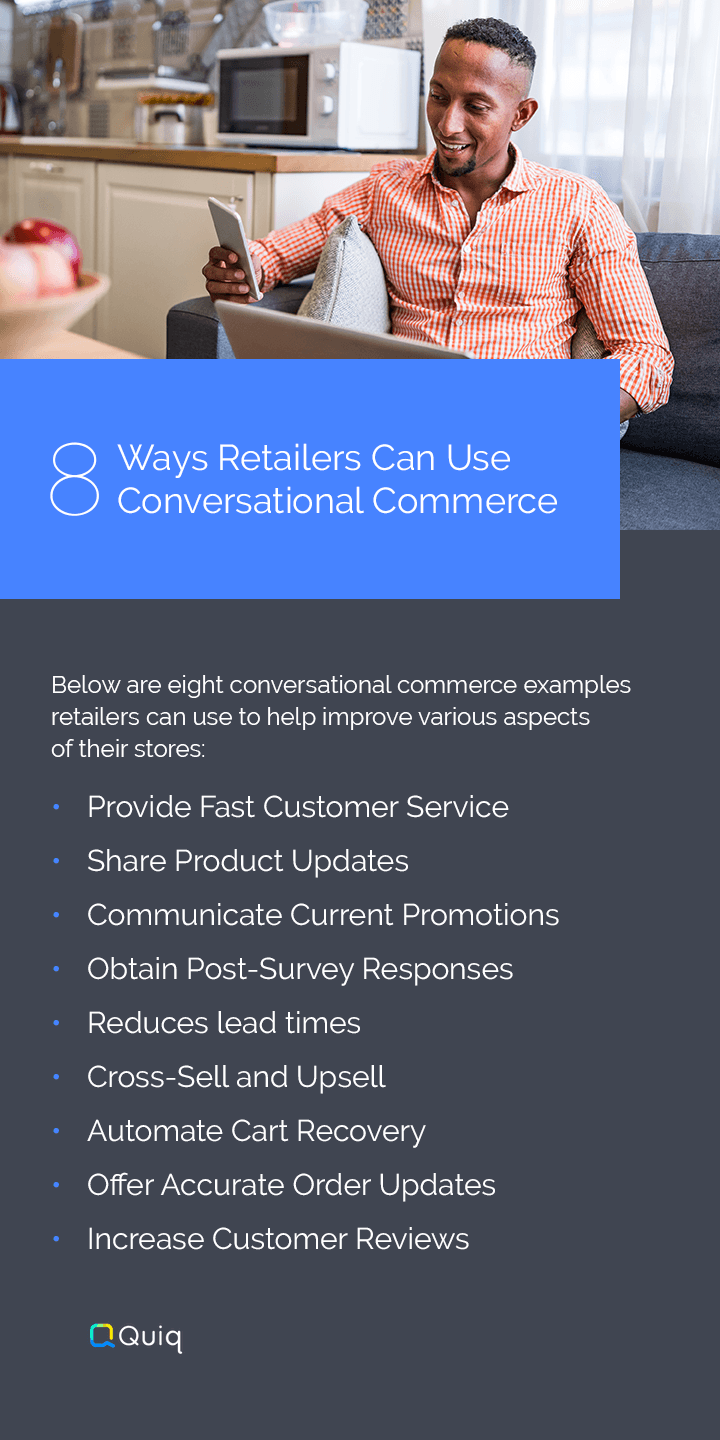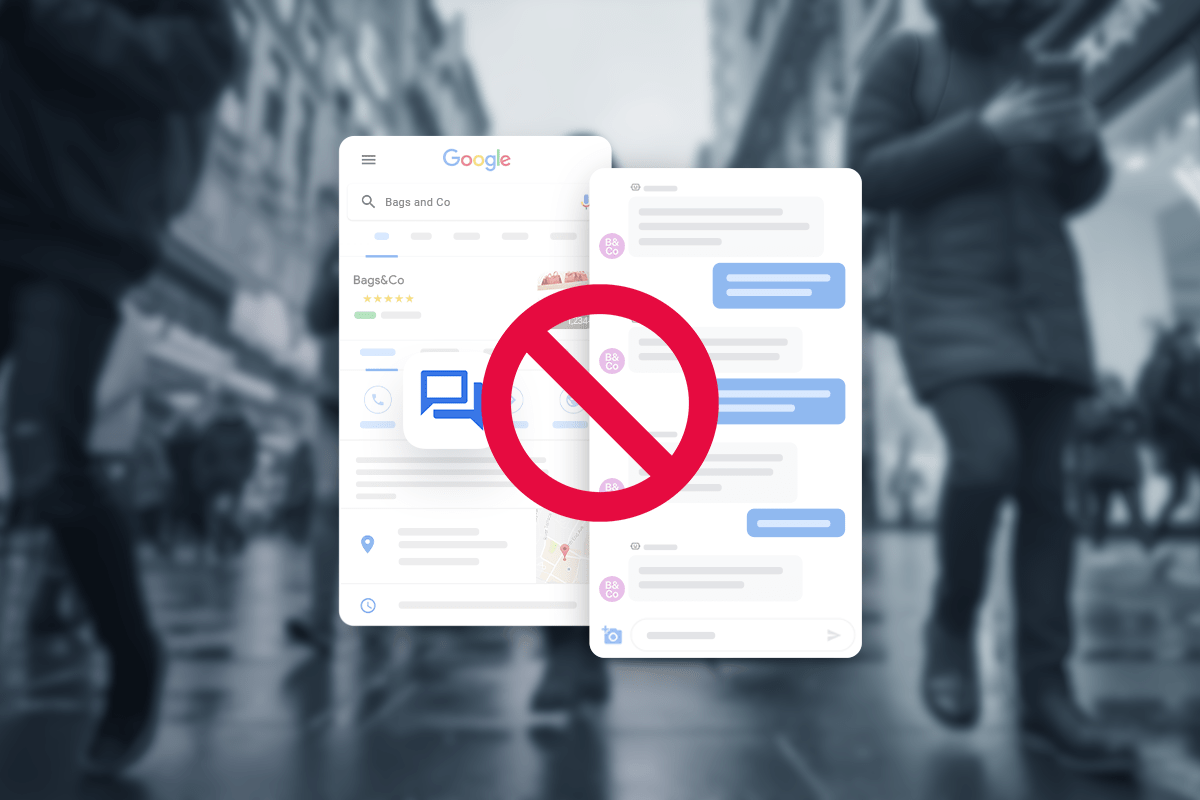Conversational commerce isn’t just a catchy alliteration — it’s a trend taking the retail world by storm. Conversational commerce refers to transactions that take place between consumers and brands through digital conversations. These conversational commerce platforms can be powerful tools, especially in a market that’s increasingly moving away from in-store shopping.
In this article, we look at how to use conversational commerce to enhance online retail experiences. We’ll dive into the market trends regarding in-store and online shopping, the benefits and uses of commercial commerce for online shopping, and how conversational commerce works so retailers can enhance their consumers’ online retail experiences.
COVID-19’s Impact on Retail Businesses
Retail shopping has primarily relied on in-store experiences in the past. In brick-and-mortar locations, consumers can physically view items and get help from in-store employees. However, COVID-19 has quickly and dramatically changed the retail landscape. With stay-at-home orders and social distancing and sanitation guidelines, new shopping trends have emerged.
As the world has started to heal from the global pandemic, country-wide lockdowns have begun to ease up. However, in the aftermath of lockdown, consumer behaviors and priorities have shifted. People’s income, values, and exposure to alternative shopping methods have shifted their preferences significantly, powering numerous market trends since the beginning of the pandemic.
Some common changes in consumer behavior and preference include the following:
- Focus on health and safety: While consumer concerns about health and safety are slowly decreasing, many consumers are still uncomfortable visiting public places, especially stores they visit less frequently. In fact, nearly 70% of consumers in markets where the pandemic is stabilizing are still concerned for the health of others.
- Focus on digital experiences: The lockdowns that resulted from the pandemic created a surge of eCommerce, especially from new consumers who’d previously never used online shopping options. Now that more consumers are aware of their online shopping options and how to use them, consumers will likely continue using these services and push toward improved online experiences.
- Increased convenience: Even before COVID-19, consumers were moving toward more convenient shopping experiences as a collective. The pandemic rapidly pushed this trend forward. As a result, many retailers had to quickly implement services focused on conveniences, such as online shopping options, curbside pickup options, and delivery services. Even as the world emerges from the pandemic, consumer preferences for convenience will likely push retailers to maintain or expand these services.
The challenge for retailers is that they need to leverage these trends and adjust their practices with changing consumer preferences. Conversational commerce is one way that retailers are working toward these adjustments.

The Benefits of Conversational Commerce For Shoppers
Conversational commerce has risen as a consumer and retailer favorite since the beginning of the pandemic. Conversational commerce works by using chatbots, brand specialists, and messaging platforms to enable conversations between consumers and a brand. These conversations often occur on messaging platforms like web chats, text messaging apps, Apple Business Chat, and even Facebook Messenger. Chatbots power many of these operations, which process messages from consumers to provide relevant responses, involving a live customer service representative if needed.
Conversational commerce platforms provide consumers with an on-demand shopping interface that enables them to engage with a live or virtual representative that can assist them with anything they need. This convenience presents shoppers with a wide range of benefits, including the following:
- Enhanced customer support: Conversational commerce platforms give consumers access to a live or virtual assistant at any time, anywhere. The assistant can answer their questions, help them preview products, and even complete transactions using the digital channels consumers prefer, including text, live chat, and social media messaging platforms.
- Faster resolution: Chatbots in conversational commerce platforms also help streamline the problem resolution process. Bots can answer the majority of common questions and route consumers to a live specialist if the problem is more complex. This process results in quick resolution times — many people use chatbots for quick problem resolution when they are concerned with their shopping experience.
- Less research: Chatbots also help streamline the shopping experience for consumers. Instead of browsing page after page to find what they want, consumers can give a description of the product to a chatbot. The chatbot’s artificial intelligence then uses the description to find a product that best suits the consumers’ needs, which reduces the time they spend browsing for products, making the experience more pleasurable.
- Greater personalization: One of the big trends among consumers today is a desire for personalization. Today, nearly 80% of consumers want more personalization from retailers to enhance their shopping experience. Conversational commerce helps with personalization by connecting consumers with support teams that offer specific product recommendations and offers.
- More touchpoints: Conversational commerce gives consumers multiple points of communication to reach brands. Retailers can add chatbots and text messaging communication to email and phone calling methods, maximizing the touchpoints available for consumers. This way, consumers can talk with their retailers in the way they’re most comfortable.
These benefits have already significantly impacted the online retail world, especially when considering that more consumers want shopping experiences that offer messaging services for support. In this way, conversational commerce is incredibly helpful for shoppers.

The Benefits of Conversational Commerce for Retailers
In addition to benefitting consumers, conversational commerce helps retailers improve their eCommerce operations. Some of the most significant benefits retailers experience from implementing conversational commerce include:
- Improved responsiveness: Conversational commerce presents an effective way to generate engagement with consumers. When retailers send in-app messages to consumers, they can get five times more opens than push notifications. As a result, consumers are more likely to respond to those messages.
- Enhanced efficiency: Chatbots are also cost- and time-efficient compared to live chat options. Chatbots can handle the majority of questions quickly, respond to hundreds of consumer questions at once, and are running around the clock. This efficiency saves time and labor for the customer service team, allowing them to direct their efforts toward the most complex tasks and problems.
- Enhanced consumer relationships: Because it’s available 24/7 and offers enhanced consumer experiences, conversational commerce helps create more positive user experiences. This feature generates goodwill between retailers and their consumers, making them more likely to be repeat buyers.
- Streamlined selling: Chatbots can promote and upsell products based on consumer queries. For example, if a buyer is looking to buy a specific type of shirt, the chatbot can show the consumer potential accessories, pants, and jackets to create a complete outfit.
- Reduced abandonment rates: Cart abandonment is a common problem for online retailers — consumers may be distracted and forget to check out, may not find an answer to a question they have about the product, or simply second-guess themselves. Commercial commerce helps reduce cart abandonment by offering responses to questions quickly, reaching out to consumers with unfinished orders, and checking in on consumers as they browse a website.
- Abundant data: Commercial commerce platforms are also valuable sources of consumer data. Tracking behaviors, issues, and questions can help strengthen retailers’ ability to create powerful marketing campaigns and improve their online platforms.
With these numerous benefits to both consumers and retailers, it’s no wonder that conversational commerce is booming. The market size of conversational commerce platforms was estimated to be around $5.94 billion in 2019 and is expected to grow to $30.45 billion by 2027.

8 Ways Retailers Can Use Conversational Commerce
Conversational commerce is a powerful way to address the changing priorities of consumers. The question is how to use conversational commerce from a practical perspective, which will be different for every retailer.
There are multiple ways retailers can use chatbots and automated conversations in their retail stores. Below are eight conversational commerce examples retailers can use to help improve various aspects of their stores:
1. Provide Fast Customer Service
One of the common ways retailers use conversational commerce is as a customer service program. Using this approach, retailers automate responses to consumer questions, which can include everything from product questions and sales to order problems. The system can also be set up to route the shopper to a live support specialist if their issue is more complex.
If retailers can provide quick access to reliable, helpful customer support, consumers will be more likely to make a purchase, as they won’t have to wait around for an answer to their question or concern.
2. Share Product Updates
Retailers can also use conversational commerce to share product updates with previous buyers. New models, software updates, and sales can all be shared via SMS or messaging services, keeping consumers informed about their options and encouraging them to buy or upgrade. This feature allows consumers to continue buying from the same retailer rather than seek out another store when they need a new product.
3. Communicate Current Promotions
Many consumers report that discounts affect their decision to complete an online purchase. Retailers can lean into this trend by using conversational commerce to communicate promotions. Send out text messages to consumers notifying them of sales and use a website chatbot to alert visitors when they arrive on the landing page. Retailers can even set it up so consumers at the checkout screen see a notification of applicable discounts when they start the checkout process.
4. Obtain Post-Survey Responses
Every retailer wants feedback from their consumers, especially if they’re looking to make a change. To ensure they get plenty of accurate responses, retailers can set up a conversational commerce platform to reach out to consumers and visitors for surveys. Retailers can send surveys for products after consumers have received them or set up a questionnaire on their website to ask consumers how they can improve.
5. Cross-Sell and Upsell
Upselling and cross-selling strategies help retailers earn more money by selling products to consumers at the checkout page. Retailers can set up a bot to suggest items commonly purchased with the products in a consumers’ cart or notify them of an upgrade option. Shops can also utilize messaging services to notify recent purchasers of accessories they may want for their new product.
6. Automate Cart Recovery
Abandoned carts are a common issue for retailers, but commercial commerce can help. In the event that a shopper abandons their cart, a retailer can set up their system to send out an automated message to the consumer. Retailers can also program commercial bots to offer a cart recovery option, so it’s even easier for the consumer to return to their potential purchase. Discounts can also be effective in this situation, so retailers may want to push discount offers to people who abandon their carts as an incentive to finish buying.
7. Offer Accurate Order Updates
Everyone knows the feeling of anticipation when they place an order. Stores can generate goodwill with their consumers by offering order updates to let them know when their order is processed and sent out. Delivery notifications are also a practical option. Retailers can set this feature up through text, messaging services, or email, so their consumers get the information they need using their preferred communication method.
8. Increase Customer Reviews
Reviews are a powerful marketing tool for consumers — 91% of younger consumers between the age of 18 to 34 rely on online reviews. Therefore, it’s essential to collect reviews for your products. Conversational commerce is a powerful way to automate reaching out for reviews. Set up automated messages after a shopper has received their product asking for quick reviews or surveys. Be sure to ask questions consumers can easily answer from a mobile phone, such as satisfaction ratings, photos of the product, shoutouts on social media, and short written or video reviews.
How to use conversational commerce depends highly on a retailer’s priorities and operations. Before crafting a solution, retailers should consider their store’s goals, identify opportunities for improvement, and look at their current contact options. Some conversational commerce methods will work better than others, so it’s essential for retailers to develop a solution that addresses their unique needs. Testing specific variables will ensure retailers get the most out of their conversational commerce solutions.
Now is the perfect time for retailers to enhance their online stores with conversational commerce. If you’re interested, Quiq is here to help you get started.
Explore Conversational Commerce for Retail With Quiq
Conversational commerce is an ideal way to address the changing needs of consumers in a post-pandemic world. But even beyond COVID-19, your retail business can benefit. This type of platform offers a personalized experience for consumers while improving productivity, supporting customer service, boosting retention, and increasing sales. There are many ways to implement conversational commerce in your retail store, and Quiq is here to help you every step of the way.
Quiq is a conversational consumer engagement platform that helps retailers deliver exceptional customer experiences. Our platform supports messaging across text messaging, web chat, social, Apple Business Chat, and Google’s Business Messages, so you can use as few or as many channels as you need to communicate with your consumer base. With easy integration, multiple bot options, and rich messaging experiences, Quiq has everything retailers need to incorporate conversational commerce into their stores.
Try Quiq for yourself today by scheduling a live demo.





